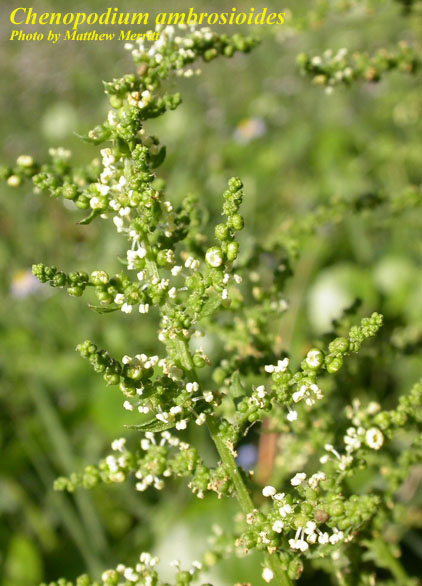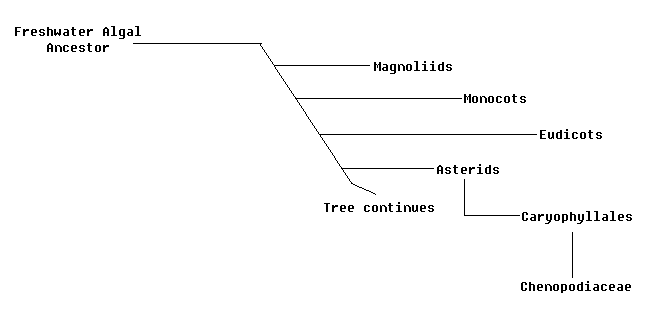Classification
 Domain:
Eukarya
Domain:
Eukarya
Kingdom:
Plantae
Phylum:
Magnoliophyta
Class: Magnoliopsida
Order: Caryohyllales
Family:
Chenopodiaceae
Genus:
Chenopodium
Species:
Chenopodium ambrosioides
Characteristics that determine why the organism is
grouped into each specific category include:
 Eukarya:
Nuclear envelope
with two membranes, membrane bound organelles, true nucleus, and
a cytoskeleton
Eukarya:
Nuclear envelope
with two membranes, membrane bound organelles, true nucleus, and
a cytoskeleton
Plantae: Photosynthetic, share a freshwater algal ancestor, cell walls
of cellulose, and express an alternation of generations
Manoliophyta: Angiosperms, seeds are covered, produce
flowers and fruits, and have a dominant sporophyte gerneration
Magnoliopsida: Dicotyldedons, vascular bundles
usually born in a ring around pith, and most have a primary root system
derived from the radical
Caryophyllales:
Most of the time stems have concentric rings
of xylem and phloem or of vascular bundles, a central protein
crystal (unlike most eudicots that have sieve tube plastids with
starch grains), and phloem sieve tubes that contain plastids with outer ring
of proteinaceous filaments
Chenopodiaceae:
Contain pigments called betalains, annual or
perennial, monoecious, dioecious, or polygamous, evergreen or
deciduous, jointed stems, aromatic bark, flowers are bisexual or
unisexual, usually simple leaves that alternate, but are
occasionally opposite of eachother
Chenopodium: Goosefoot family, goosefoot
refers to the shape of the leaves
Chenopodium ambrosioides:
ambrosioides
refers to the plants resemblance to Ambrosia, more commonly
known as the ragweeds
If you would like to learn more about the phylum Magnoliophyta check out Papaver somniferum, better known as the opium poppy, Psidium guajava, and Citrus Sinensis.
Common names:
American Wormseed, Jerusalem parsley, Mexican tea, Sweet
pigweed, West Indian Goosefoot, Wormseed Goosefoot, hedge mustard,
skunkweed, and Wormseed. Many of these names are either referring to
the plant's pungent odor or its ability to fight intestinal
worms, for more information on the plants uses in medicine see
Medicinal Uses.
To better understand the complex relationships of plants I will next explore the topic of plant phylogenies. Phylogeny refers to the developmental and evolutionary history of an organism. Phylogenies can be put together based on information gathered in numerous ways, but the trees I have chosen to feature were put together based on the exploration of many specific genes within the plant kingdom. It's important to understand that these phylogenies are in flux at the moment and many studies are being done to determine the relationships of plants, especially the Chenopodiaceae family. These phylogenies that I have constructed through my research are subject to change, but represent the most accurate and up to date information.
The phylogenetic tree pictured above is a representation of the Angiosperms as a whole and was constructed based on genetic analysis. I chose to leave out the nonvascular, seedless vascular, and gymnosperms which come before the branching of the angiosperms on the larger tree of life. The Magnoliids were the first to branch followed by the Monocots and then the Eudicots. The Asterids is a clade of the core Eudicots but they branch later in the tree. The order Caryophyllales is one of many branches of the Asterids. The Asterids then breakdown into three families. One of which is Chenopodiaceae, which is broken down further in the phylogenetic tree below.
The tree above takes the Chenopodiaceae family and breaks it down into the three species based on genetic analysis and depicts its closest relative to be the Amaranthaceae family. The Spinacia genus is mostly closely related to Chenopodium and contains plants such as spinach. The genus Beta is still a part of the Chenopodiaceae family, but not as closely related to the Chenopodium genus. Each genus breaks down even further, but considering there are over 100 members of the Chenopodium genus keep in mind this is a condensed version of a much larger tree.
*Disclaimer* The phylogenetic trees were constructed based on information found in scientific journals, online, and my own interpretation of this information. These trees are by no means set in stone and are subject to change.

